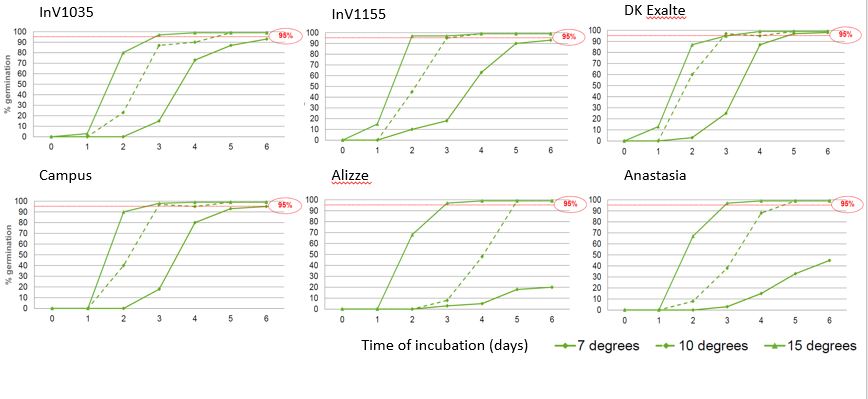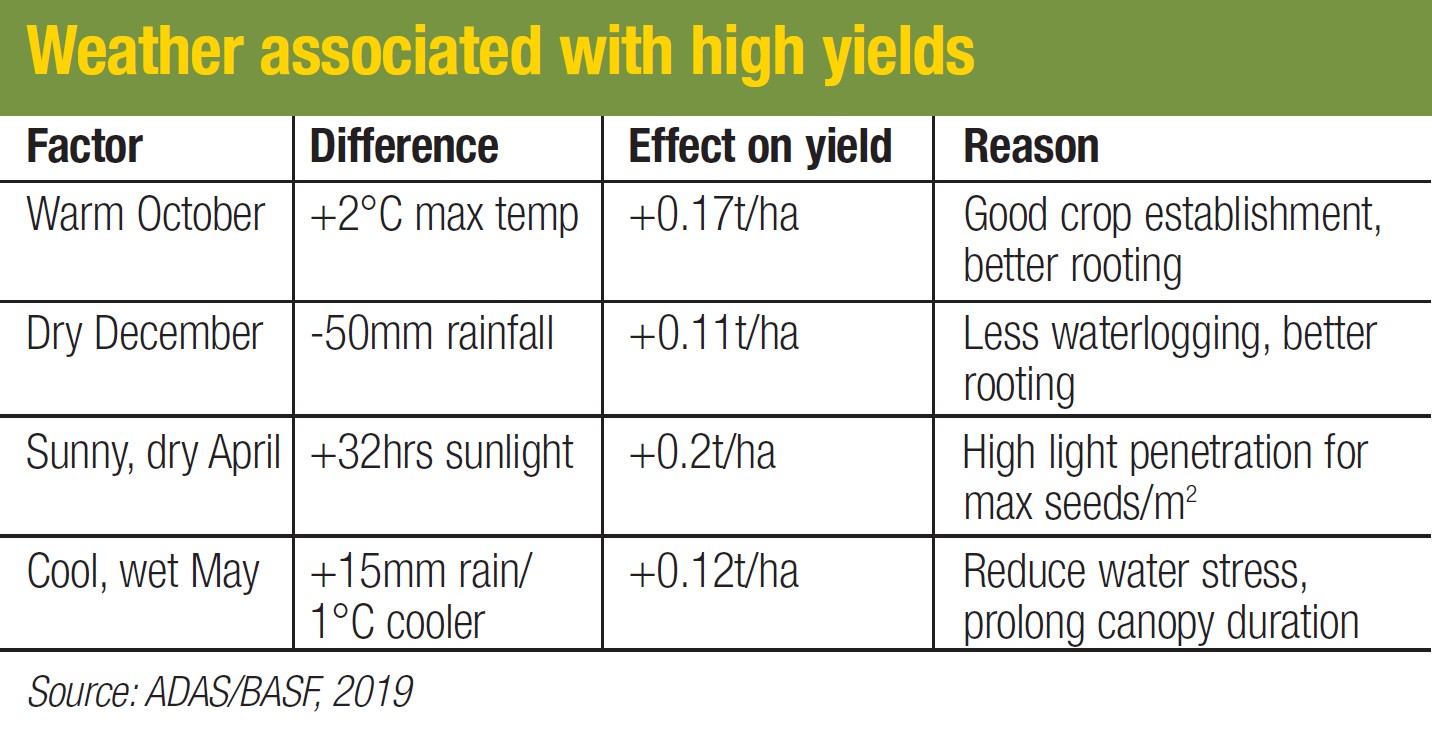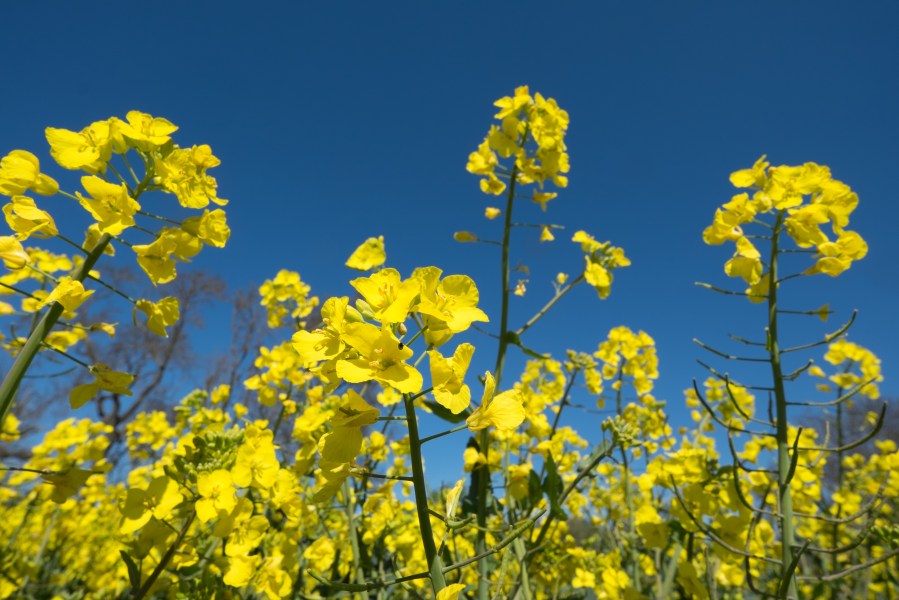Now under new ownership, the InVigor hybrids have another choice for growers looking for strong vigour in the late-sown slot. CPM reviews InV1155 and some of the research aimed at getting the best from the variety.
If growers are pushed to later sowing this variety has the vigour to get away quickly.
By Tom Allen-Stevens
Vigour seems to be the buzzword in oilseed rape at present, and there’s one player in the market with such confidence on this score, it’s even built the word into the brand name.
InV1155 is one of the latest offerings from the InVigor stable, now owned by BASF, after Bayer was forced to divest its seed portfolio on purchasing Monsanto last year. It joins InV1035, a variety exclusively available from Agrii that’s taken an impressive 10% of the non-Clearfield hybrid market, says BASF’s Dr Carol Norris.
So how does InV1155 shape up against its stable mate? “Those two are the most vigorous varieties in our portfolio,” she says. “They lose less yield than many other varieties when sown late. If you’re a grower aiming for the late window, InV1035 and InV1155 stand out as the best options to go for.”
This assertion follows quite a bit of research undertaken into the InVigor varieties, previously by Bayer, and now by BASF. That’s the aspect many growers may find interesting, and it’s certainly something that’s attracted United Oilseeds, one of three UK agents for InV1155.
“In terms of the agronomic ratings for InV1155, we value the trials data from BASF and believe that growers can have confidence in both the seed breeder’s information and the variety’s performance,” says the company’s seed manager Beckii Gibbs.
“As a hybrid, InV1155 ticks all the boxes for a good dependable variety. It has a high gross output, scoring 110% in proprietary trials, a stand-out seed yield of 111% and a high oil content at 45.2%. Combined with a strong disease package which features an 8 for phoma resistance and a 7 for light leaf spot, it offers growers a powerful overall agronomic package.”
Gleadell’s Chris Guest has very similar impressions of InV1155. “It ticks a lot of boxes for a reliable hybrid variety. It has solid gross output potential, made up of high oil contents – something seen in a wide range of InVigor varieties – good, all-round disease resistance, pod shatter resistance and early maturity,” he says.
“One of its stand-out features is the autumn growth which means if growers are pushed to later sowing this variety has the vigour to get away quickly.”
And this is the feature that seems to lie at the heart of both InV1155 and its more established stable mate InV1035. Vigour isn’t yet recognised on the AHDB Recommended List, however, notes BASF product manager for seeds Sarah Middleton.
“It’s surprising because we believe establishment is the number one priority for growers, which is why we’ve done research in this area. NIABTAG trials show InV1035 as one of the top scorers on early vigour, and InV1155 is a very similar low risk, high output variety.”
Neither are on the RL, however, although were close to being selected as candidates, points out Carol. “They don’t really suit the RL system, that establishes plots at 60-70 seeds/m² to ensure the whole trial is viable. InVigor varieties are best sown at 30-40 seeds/m², which will not suit all varieties and in a trial with lower populations such as this, some plots will not establish at all, so the whole trial is discounted. But in our experience, that’s the population at which they thrive.”
It means a lack of industry-standard independent stats on the varieties, and up-to-date figures are only available through BASF proprietary trials. So how can growers have confidence they will perform? Chris doesn’t see it as a problem. “Similar questions could be asked of numerous successful varieties that have been grown in the UK over many years and don’t appear on the RL. This is the case for much of the Dekalb material in particular.”
InV1155 comes from the same stable as Harper, he points out, that quickly became a growers’ favourite. “These varieties have strong disease resistance, particularly to phoma/stem canker. This enables growers to target light leaf spot spray timings. With its high LLS rating, InV1155 will be an excellent partner to varieties which are perhaps not as strong on disease.
“It fits the main drilling window but is also suitable for later sowing. Medium/early to harvest, it spreads the harvest workload.”
The variety will particularly suit a grower who’s looking for good autumn and spring vigour, notes Beckii. “A vigorous growth habit in autumn has increased in importance because of the geographical spread of cabbage stem flea beetle, as it means the plant can grow away from pest attack and establish more quickly. InV1155’s spring vigour rating is also equal to that of DK Extrovert.”
Medium maturing and late flowering, InV1155 also has pod shatter resistance. “With an 8 for lodging resistance, it should prove durable during adverse weather conditions and stand to the reel well at harvest,” she adds.
Carol confirms InV1155 is very similar in vigour, disease resistance and pod-shatter tolerance to InV1035. “It’s National List yield figures put it a shade below its stable mate, it’s slightly later to mature and a little bit taller.”
The latest NIABTAG trial results show InV1035 has verticillium wilt tolerance equal to industry-standard Catana, she notes and initial results from internal tests in 2018 suggest InV1155 may also show a level of tolerance. “The trials are being repeated this year for confirmation.”
InV1155 first went on sale last year, which coincided with the hand-over of the InVigor portfolio from Bayer to BASF. Growers purchase the varieties through the same agency model as before – an on-line portal where you have to sign up to terms and conditions. It’s a one-off procedure designed to ensure full traceability in the advent of any novel traits that may become available in future.
The change of ownership itself has gone very smoothly, all things considered, says Carol. “It was a difficult time for us to move last Aug, coinciding with our busiest time of the year. We’ve now been through a ‘discovery phase’ with our new colleagues, and there’s a renewed enthusiasm on all sides. We have new tools to explore, such as Clearfield, Caryx and a host of other products in the BASF portfolio.”
One example is Integral Pro (Bacillus amyloliquefaciens), a new biological seed treatment claimed to strengthen OSR plants and stimulate their natural defence mechanisms against pests and diseases. It’s due to be available to UK growers for the first time this autumn, says Sarah.
“It’s great to have access to the very strong BASF OSR product portfolio. Going forward, there’ll be more of a systems approach, with the seed-related aspects feeding into current research we’re doing with ADAS and others. This will help us really understand how we can join the pieces of the puzzle together.”
The research that underpins the InVigor lines

Variety selection can be an important factor in OSR establishment under low temperatures, according to BASF-funded research carried out by Nottingham University.
“It’s generally recognised that hybrids are more vigorous than conventional varieties, but how do you measure vigour?” asks Dr Steve Rossall who carried out the research. “One way to do so is to study the germination at low temperatures.”
He took 15 varieties, including eight InVigor hybrids, and compared the time of incubation at three different temperatures. “All the varieties we tested performed about the same at 15°C, but there were big differences at low temperatures.”
InV1035, InV1155 and DK Exalte did best at the lower temperatures, notes Steve. “This could have particular significance in the North and Scotland – a variety that can germinate quickly has a better chance of tolerating other problems.”
Another recent study, carried out by ADAS, has looked at the impacts of weather and frequency of drought in OSR. Using average UK OSR yield data from Defra from 1979-2017 and UK monthly mean weather data, the study set out to investigate the weather factors associated with high or low OSR yields.
“We wanted to consider what physiological processes were taking place in the crop when these specific weather events associated with yield fluctuations and how we can mitigate against non-ideal conditions,” notes Dr Christina Clarke of ADAS.

The study concluded that overall, five weather factors accounted for 37% of yield variation, of which four key ones are summarised in the table.
So what can be done to mitigate against weather conditions that aren’t conducive to high yields? Two factors in particular can be countered by choosing a variety with good early vigour, notes Christina – seasons in which there’s a cold Oct and/or a wet Dec.
“A warm Oct encourages bigger stronger plants with better rooting, more able to tolerate pests and phoma and kick off quickly in the spring. Apart from variety choice, a good seedbed is important, and timing of drilling to make the most of available soil moisture. Bigger biomass plants resist early pest pressure better.
“Water-logged soils in Dec affect OSR plants. Their roots don’t have the ability to form aerenchyma, or soft plant tissue containing dead air spaces which can be found in cereal roots. Anaerobic soil conditions can therefore quickly affect photosynthetic ability of OSR, which stunts root growth. So drainage is important, but also plant vigour – where there’s vigorous growth before Dec, the crop is less affected by water-logging,” she adds.
The significance of the research to BASF’s Clare Tucker is that it quantifies the factors in OSR. “So if you put in measures to mitigate against adverse conditions, or bolster the effect of favourable weather, you know the sort of return on investment you can expect.”
In spring, for example, nitrogen management and PGR use can let more light down to improve seed set in the lower canopy. “In high yielding crops 60% of yield comes from the lower canopy. A PGR used at yellow bud will also encourage secondary branching, which may help compensate for CSFB larval damage in the main stem, but we’re doing work to test this theory,” she adds.
She advises using Caryx (mepiquat chloride+ metconazole) from green-bud through to yellow-bud timing. “It has stronger effects on shortening and lodging control when applied at the start of stem extension and stronger canopy effects when applied at yellow bud. ADAS field studies have also shown Caryx increases rooting at depth, which may help mitigate a dry summer.” Only crops with a green area index above 0.8 before stem extension in late Feb should be treated, she notes.
BASF-funded work on green-leaf area duration, carried out by ADAS over four sites in 2017 and 2018, has shown a yield benefit of 0.2t/ha from applying Filan (boscalid) at flowering. “It protects you against sclerotinia, but in a low disease year it also buffers you when conditions aren’t ideal,” reasons Clare.




